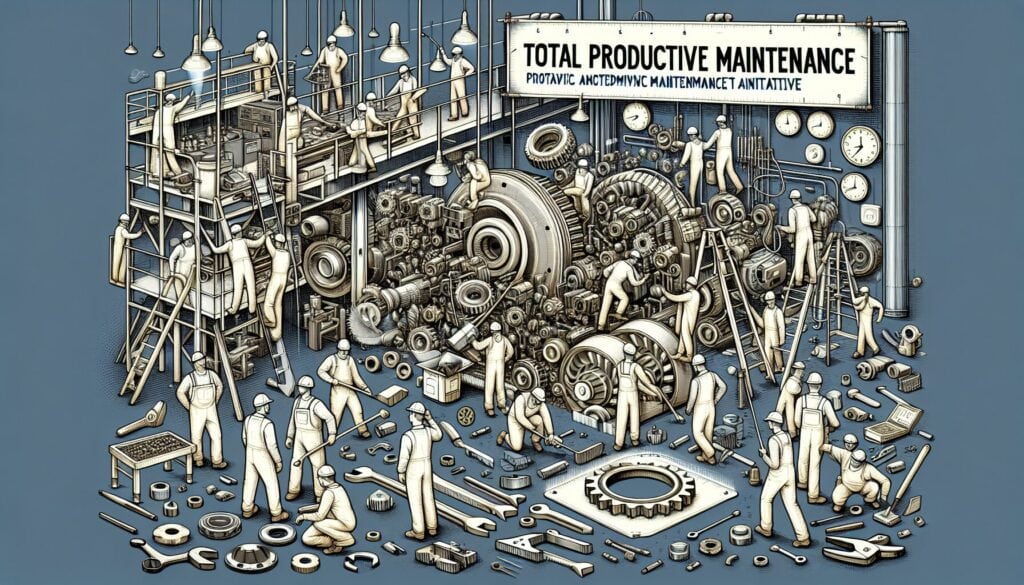Erreichen einer nahezu perfekten Produktion (keine Ausfälle, keine kleinen Stopps oder Langsamläufer, keine Defekte und keine Unfälle) durch einen proaktiven, ganzheitlichen Ansatz, der alle Mitarbeiter in die Wartung der Anlagen einbezieht.
- Methodologien: Maschinenbau, Qualität
Total Productive Maintenance (TPM)

Total Productive Maintenance (TPM)
- Kontinuierliche Verbesserung, Schlanke Fertigung, Schlanke Produktion, Wartung, Gesamtanlageneffektivität (OEE), Prozessverbesserung, Produktivität, Qualitätsmanagement, Sicherheit
Zielsetzung:
Wie es verwendet wird:
- Ein System zur Aufrechterhaltung und Verbesserung der Integrität von Produktions- und Qualitätssystemen mit Hilfe von Maschinen, Anlagen, Prozessen und Mitarbeitern, das einen Mehrwert für ein Unternehmen schafft. Der Schwerpunkt liegt auf der Befähigung der Bediener, bei der Wartung ihrer Anlagen mitzuwirken (autonome Wartung).
Vorteile
- Erhöht die Anlageneffektivität (OEE) und -zuverlässigkeit; verringert Ausfallzeiten und Wartungskosten; verbessert die Sicherheit und Produktqualität; steigert das Engagement und die Moral der Mitarbeiter.
Nachteile
- Erfordert einen erheblichen Kulturwandel und langfristiges Engagement; kann kostspielig und zeitaufwendig sein, um vollständig umgesetzt zu werden; erfordert umfangreiche Schulungen für Betreiber und Wartungspersonal.
Kategorien:
- Maschinenbau, Personalwesen, Lean Sigma, Herstellung, Qualität
Am besten geeignet für:
- Maximierung der Effektivität der Ausrüstung und Lebensdauer durch eine umfassende, proaktive Instandhaltungsstrategie, die alle Mitarbeiter einbezieht.
Total Productive Maintenance (TPM) ist in verschiedenen Branchen weit verbreitet, insbesondere in der Fertigungsindustrie, der Automobilindustrie und der Lebensmittelverarbeitung, wo die Betriebszeit der Anlagen für die Aufrechterhaltung der Produktionseffizienz und -qualität entscheidend ist. Im Rahmen von Projektphasen kann TPM in die Entwurfs- und Entwicklungsphase integriert werden, wo der Input von Betreibern zu wartungsfreundlicheren Anlagendesigns führen kann, die die Betriebsleistung verbessern. Häufig werden funktionsübergreifende Teams eingesetzt, zu denen Instandhaltungspersonal, Produktionsmitarbeiter und Qualitätssicherungsexperten gehören, die zusammenarbeiten, um Verbesserungsmöglichkeiten zu ermitteln und Präventivmaßnahmen zu ergreifen. TPM wird von der Unternehmensleitung initiiert und beruht auf der Einbeziehung aller Mitarbeiter, die dazu ermutigt werden, die Verantwortung für die von ihnen betriebenen Maschinen zu übernehmen, was zu einer Kultur der kontinuierlichen Verbesserung und Problemlösung führt. In der Automobilindustrie hat die Einführung der TPM-Grundsätze zum Beispiel Folgendes bewirkt geführt zu einer deutlichen Verringerung von Anlagenausfällen und ungeplanten Stillstandszeiten und ermöglicht es Unternehmen, ihre Gesamtanlageneffektivität (OEE) zu verbessern, indem sie die Leistungsmetriken genau überwachen und datengestützte Entscheidungen treffen. Mitarbeiter, die an TPM-Initiativen teilnehmen, berichten außerdem von einer höheren Arbeitszufriedenheit und einem stärkeren Verantwortungsgefühl, was sich in einer verbesserten Arbeitsmoral und Produktivität niederschlägt. Diese Methodik zielt nicht nur auf Instandhaltungsaufgaben ab, sondern konzentriert sich auf einen ganzheitlichen Ansatz zur Verbesserung der Prozessfähigkeiten, der sicherstellt, dass Unternehmen sich schnell an Veränderungen der Nachfrage oder der Produktionsmethoden anpassen können und gleichzeitig hohe Sicherheits- und Qualitätsstandards einhalten.
Die wichtigsten Schritte dieser Methodik
- Führen Sie eine erste Bewertung der Ausrüstung durch, um den aktuellen Zustand und den Wartungsbedarf zu ermitteln.
- Umsetzung der autonomen Wartung durch Schulung der Bediener zur Durchführung von Routinekontrollen und kleineren Reparaturen.
- Aufstellung regelmäßiger Wartungspläne für vorbeugende und vorausschauende Wartungsmaßnahmen.
- Standardisierung von Betriebsabläufen, um eine gleichbleibende Leistung zu gewährleisten und die Variabilität zu verringern.
- Integration der TPM-Grundsätze in die täglichen Arbeitsabläufe zur kontinuierlichen Verbesserung.
- Durchführung von Ursachenanalysen für Pannen und Umsetzung von Korrekturmaßnahmen, um ein erneutes Auftreten zu verhindern.
- Einbindung aller Mitarbeiter in TPM-Aktivitäten, um eine Kultur der gemeinsamen Verantwortung zu fördern.
- Verwenden Sie visuelle Management-Tools, um den Wartungsfortschritt und den Status der Ausrüstung zu verfolgen.
Profi-Tipps
- Implementierung eines strukturierten Schulungsprogramms für Bediener, damit diese Anzeichen von Anlagenproblemen frühzeitig erkennen können, was ein frühzeitiges Eingreifen und vorbeugende Maßnahmen fördert.
- Nutzen Sie die Datenanalyse für die Echtzeitüberwachung, die eine vorausschauende Wartung und eine optimierte Planung zur Minimierung von Störungen ermöglicht.
- Ermutigen Sie funktionsübergreifende Teams zur Bewertung und Analyse der Anlagenleistung und sorgen Sie für vielfältige Beiträge und innovative Lösungen zur kontinuierlichen Verbesserung.
Verschiedene Methoden lesen und vergleichen, Wir empfehlen die
> Umfassendes Methoden-Repository <
zusammen mit den über 400 anderen Methoden.
Ihre Kommentare zu dieser Methodik oder zusätzliche Informationen sind willkommen auf der Kommentarbereich unten ↓ , sowie alle ingenieursbezogenen Ideen oder Links.
Historischer Kontext
1962
1970
1972
1980
1980
1986
1986
1960
1963
1970
1980
1980
1980
1986
1987
(wenn das Datum nicht bekannt oder nicht relevant ist, z. B. "Strömungsmechanik", wird eine gerundete Schätzung des bemerkenswerten Erscheinens angegeben)















Verwandte Artikel
Master Production Schedule (MPS)
Massenanpassung
Marketing-Trichter
Marketing-Audit
MAPO-Index (Bewegung und Unterstützung von Krankenhauspatienten)
Fertigungsressourcenplanung (MRP II)